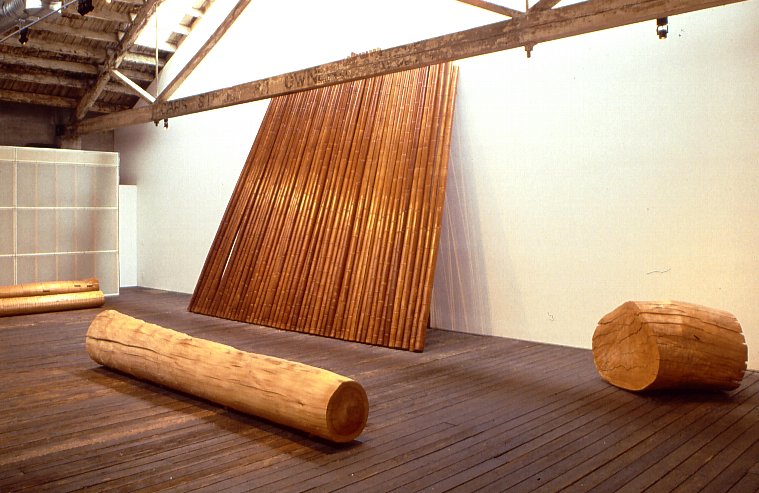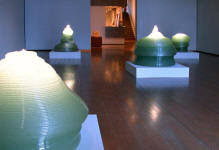Artweek Reviews Washington
March 2003, Vol. 34 Issue 2

| Kazuo Kadonaga at Greg Kucera Gallery and Suyama Space |
At Kucera Gallery, a single light was focused on the tip of every one of Kadonaga's five oversized glass works. Each slightly green mound of glass weighs approximately 1,500 pounds, and the artist made the molten glass to flow slowly from a furnace into a cooling chamber below. The resulting works are quietly beautiful in a way that acts as a needed antidote for a city long inundated with glass as a mere coffee table decoration. The installation is simple and dramatically lit; an almost theatrical presentation of what was a repetitive collaboration between the artist and his materials, as well as the materials and the natural laws of physics.
Greg Kucera identifies the 1960s Japanese Mono-Ha (Object Group) as an influence on Kadonaga. Those unfamiliar with that particular brand of process oriented, conceptual art may be reminded of Richard Serra's melted lead pieces thrown against the floor, or Barry LeVa's collection of cut felt of the same era. Kadonaga's work like the early work of Serra and LeVa is deceptive. The resulting pieces are more than just beautiful and spare. It has often been noted how the formal artists from the '60s and '70s eschewed the term "minimalist" that was often used to describe their work, and in looking at Kadonaga's work, it is obvious why Like them, Kadonaga makes art that is a mediation between the artistfs hand and materials. The resulting pieces are evidence of human actions and interactions with natural forces.
Suyama Space, because of its size and the different variety of materials and objects exhibited, makes this most apparent. Upon entering, one is immediately confronted with fifty-one dark bamboo poles approximately 15 feet tall. To the left, is a pad of paper nearly 9 feet long and more than 2 feet high. Throughout the room are large elegant logs, some as
long as 16-1/2 feet. The large logs in this space (like the three smaller ones in the back part of the Kucera Gallery), are sliced in various ways. The pieces are either re-stacked, or partially cut, then by being exposed to air and heat, nature is allowed to leave its marks. The large paper piece recalls a geologic relief, one half of its surface a gentle curve.
| Kazuo Kadonaga, (above) installation view of Pure Form, at. Suyama Space, Seattle. (Photo: Eduardo Calderon.); (below) Installation view of Glass Sculpture, at Greg t Greg Kucera Gallery Seattfe. |
 |
Frances DeVuono is a contributing editor to Artweek